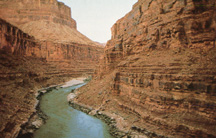Utah’s Water Storage Continues to Decline in ‘04
Water reservoirs dip to 34 percent of capacity
LeRoy W. Hooton, Jr.
October 8, 2004
|
Notwithstanding the slower drain of water reserves, many of the state’s reservoirs lost storage, and some are reaching severe conditions. Most notable is Bear Lake, which ended the year with zero usable storage. Since 1999 Bear Lake lost 1.4 million acre-feet of stored water. Likewise, three other smaller reservoirs, Gunnison, Minersville and Lower Enterprise were drained on October 1.
In the Provo River – Utah Lake – Jordan River Drainage all of the major reservoirs lost water during the past year. Jordanelle Reservoir lost 32,100 acre-feet; Deer Creek Reservoir 3,500 acre-feet; and Utah Lake 37,400 acre-feet of stored water. Compared to capacity, Jordanelle, Deer Creek and Utah Lake were respectively 68, 50 and 34 percent full at the end of the water year. Little Dell – Mt. Dell reservoirs lost 7 percent of their reserves during the water year, with 15,302 acre-feet in storage remaining on October 1. Water levels in Utah Lake became critically low at the end of the irrigation season on October 1 at 7 feet below compromise.
Reservoir storage in the Weber Basin improved during the past year. Rockport, Echo, East Canyon and Pineview all showed increases in stored water. Only Willard Bay experienced a substantial decrease from 45,000 acre-feet in 2003 to 24,400 acre-feet in 2004. However, compared to full capacity, Weber Basin reservoirs are still well below normal. Rockport is the highest at 77 percent; Lost Creek and Willard Bay are the lowest at 10 and 11 percent respectively.
Overall water storage in the Uintah Basin remained about the same during the past year with some of the reservoirs showing decreases. Water year end storage for Currant Creek is 98 percent; Stravation 54 percent; and Red Fleet 46 percent of normal. Strawberry Reservior lost 36,300 acre-feet of water during the past year and is currently 68 percent full with 756,000 acre-feet of water in storage. Strawberry Reservoir is part of the Central Utah Project that supplies water to the Wasatch Front.
Drawing the greatest attention is Lake Powell on the Colorado River. In 1999 Lake Powell was nearly full at 24 million acre-feet. Five years later on October 1, the water volume was reduced to 9.2 million acre-feet or 38 percent of capacity. The water level in Lake Powell has
|
The question is whether the drought is over and reservoirs will begin to refill , or if this is part of an extended drought that may last for years. Utah’s storage reservoirs are only one-third full as we look to a new water year. Another year of drought could stress already depleted stored water supplies in certain reservoirs to dangerously low levels.

